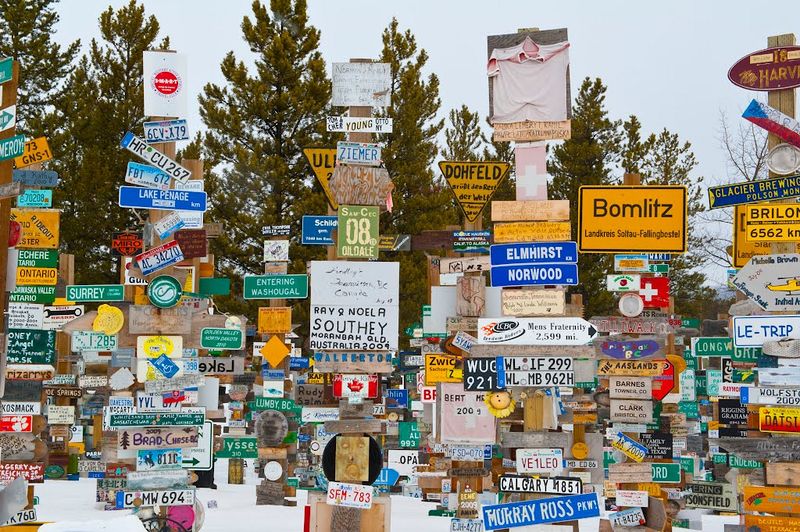

The first time we visited, there was an engine from a train. There are also a few picnic tables for a nice lunch spot. If you’re traveling with kids, they might enjoy all of the heavy equipment in the forest. I’m guessing someone took this sign without asking and planted it here. You can freely walk around and look at all the signs.Īt some point, a Civil War sign was installed. There is a little Visitor’s Center attached to the forest that is opened 8:30-4:30, but it wasn’t open any of the times we were there. I didn’t eat there because of the gluten, but the rest in my party did and liked it. There is a little store next door with groceries, gas, a laundry, restrooms and a little fast food restaurant, that isn’t super fast to be honest. The Sign Post Forest is located on the Alaska Highway, at mile marker 635 (KM marker 980), in Watson Lake. Thus, the start of something really cool. While he was painting the sign, he decided to add a sign of his own hometown.

He was seriously homesick, as you would be if you’d been injured and you had no family with you. Private Lindley’s commanding officer assigned him the task of painting the directional sign. In 1942, there wasn’t a town of Watson Lake, but a military air base and airport. The Sign Post Forest was started in 1942 by an injured US GI, Private Carl K Lindley from Danville, Illinois, who was brought to the aid station to recuperate. One place that really caught our interest was the Sign Post Forest, in Watson Lake, Yukon. We’ve done it four times now and seen different things each time. Today the replica Danville, Illinois sign is visible at the Visitor Center.Driving the Alaska Highway is a long drive, but so very worth the time it takes to do it. But in 1992, on the occasion of the 50th anniversary of the building of the Alaska Highway, Carl and his wife Elinor returned to Watson Lake after an absence of 50 years and inaugurated a replica of the directional post that Carl had erected half a century ago. Unfortunatly, the original sign put up by Carl Lindley was lost. According to Wikipedia, there are over 100,000 signs in the Sign Post Forest, and is growing each year. The logistics of moving that sign from Germany all the way to Watson Lake perplexes me.
SIGNPOST FORREST LICENSE
There are street signs, "Welcome To." signs, signatures on dinner plates, and license plates from around the world, including a 6x10-foot sign from the German autobahn. Over the years, the single signpost grew to a forest a couple of acres in size with signs added by people from all over the world. Others liked the idea and several more signs pointing to various other places were added and a tradition developed. Carl got a bit homesick, and while carrying out his task, decided to add a sign pointing towards his home town, Danville, Illinois. It gave directions and mileage to surrounding communities and various parts of the world. In those times, it was common practice for the US Army of Engineers to put up a directional post at their camps. During his time there, Carl’s commanding officer ordered him to repair and repaint the directional post that pointed to various points along the tote road.

Carl Lindley from Company D, 341st Army of Engineers, was working on the Alaska Highway near Lower Post, Canada, when he was injured and taken to the Army Aid Station to recuperate. Watson Lake didn’t exist then, but there was a Military Air Base and airport on the site.

Lindley in 1942, at a time when the Alaska Highway was being built. The landmark was started by Private Carl K.
SIGNPOST FORREST FULL
It’s a “forest” full of signs of various shapes and sizes hammered into vertical wooden posts driven into the ground. One of the quirkiest attraction along the Alaska Highway is located near the town of Watson Lake, in Yukon territory, Canada.


 0 kommentar(er)
0 kommentar(er)
